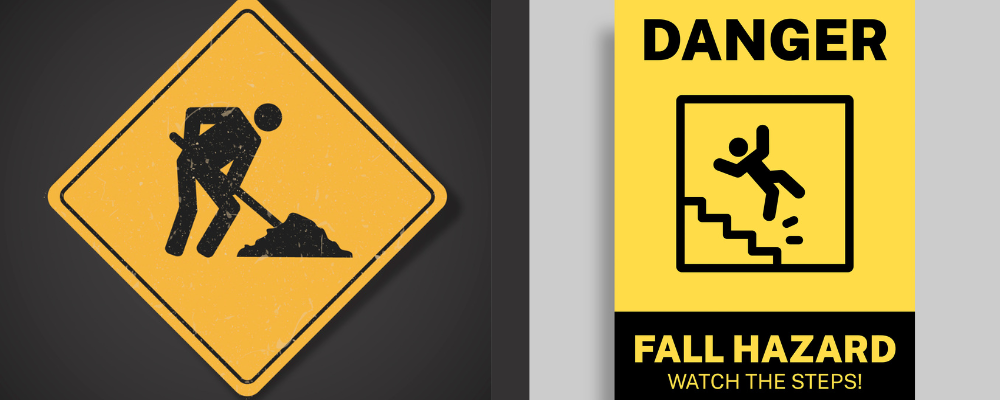
Introduction
In the bustling world of construction, safety reigns supreme. Construction workers face many hazards daily, making adherence to safety protocols paramount. Among these protocols, utilizing workers’ safety signs emerges as a cornerstone in safeguarding personnel and mitigating potential risks. In this comprehensive guide, we delve into the significance of worker safety signs and explore how they bolster safety standards on construction sites.
Why Worker’s Safety Signs Matter:
In construction sites’ dynamic and often hazardous environments, worker safety signs emerge as indispensable components of safety protocols. They play a pivotal role in ensuring the well-being of construction personnel by serving as vital communication tools. Below are several key reasons why worker’s safety signs matter significantly:
1. Hazard Communication:
Worker safety signs are instrumental in communicating essential information regarding potential hazards on the construction site. Whether it’s the presence of heavy machinery, electrical hazards, confined spaces, or slippery surfaces, these signs effectively highlight the dangers that workers may encounter during their tasks. By providing clear and concise warnings, safety signs enable workers to recognize and understand the risks associated with their work environment, empowering them to take appropriate precautions to mitigate them.
2. Guiding Safer Practices:
Beyond merely highlighting hazards, worker safety signs also guide safer practices. These signs alert workers to potential dangers and provide instructions on navigating these hazards safely. For instance, a “Caution: Wet Floor” sign not only warns of slippery surfaces but also advises workers to proceed cautiously and take measures to prevent slips, trips, and falls. By offering guidance and direction, safety signs facilitate informed decision-making and encourage adherence to safe work practices, ultimately reducing the likelihood of accidents and injuries.
3. Cultivating Safety Awareness:
The visibility and prominence of worker’s safety signs contribute to cultivating a culture of safety awareness among construction personnel. By prominently displaying these signs throughout the construction site, employers clearly message their workforce that safety is a top priority. Regular exposure to safety signage reinforces the importance of vigilance and encourages workers to remain alert and proactive in identifying and addressing potential hazards. This heightened safety awareness fosters a collective responsibility for safety among workers, creating a safer and more secure work environment.
4. Demonstrating Commitment to Worker Safety:
The deliberate deployment of worker safety signs reflects an employer’s commitment to prioritizing the safety and well-being of their workforce. By investing in quality signage solutions and ensuring their widespread implementation across the construction site, employers demonstrate their dedication to creating a safe working environment for their employees. This proactive approach protects workers from harm and instills employee confidence and trust, fostering a positive workplace culture centered around safety and accountability.
5. Regulatory Compliance:
Worker’s Safety Signs ensure compliance with regulatory standards and workplace safety requirements. Regulatory bodies mandate specific safety signs to alert workers to hazards and convey essential safety information. Failure to adhere to these regulations can result in penalties, fines, and legal liabilities for employers. By diligently implementing the required safety signage, construction companies demonstrate their commitment to compliance and mitigate the risk of regulatory violations, safeguarding their workers and their business interests.
In summary, Worker’s Safety Signs are not mere accessories but essential components of effective safety management systems in the construction industry. They serve as powerful communication tools, guiding workers through potential hazards, promoting safe practices, fostering safety awareness, and demonstrating employers’ commitment to prioritizing worker safety. By recognizing the critical importance of safety signage and integrating it into their safety protocols, construction companies can create safer work environments, protect their workforce, and uphold the highest standards of safety excellence.

Types of Worker’s Safety Signs:
In any construction setting, ensuring workers’ safety is paramount. Worker’s Safety Signs are pivotal in achieving this goal by communicating vital information regarding hazards, precautions, and safety protocols. Below, we delve into the various types of worker’s safety signs, highlighting their unique features and benefits:
-
Brady® Inspection Record Tags:
-
- Description: Brady® Inspection Record Tags offer a systematic approach to equipment inspection. These tags are designed to facilitate regulatory compliance and ensure the integrity of construction machinery.
- Functionality: They provide a visible record of equipment inspection dates, enabling construction personnel to track maintenance schedules and identify potential issues promptly. The standardized format of these tags simplifies documentation and regulatory reporting requirements.
- Benefits: By utilizing Brady® Inspection Record Tags, construction companies can streamline equipment maintenance processes, minimize downtime, and enhance workplace safety. These tags serve as tangible evidence of compliance with regulatory standards, bolstering the credibility of construction operations.
-
Brady® Standard Scaffold Status Tags:
-
- Description: Scaffold safety is a critical concern in construction, and Brady® Standard Scaffold Status Tags address this issue by providing clear indications of scaffold status.
- Functionality: These tags offer visual cues to workers, indicating whether a scaffold is safe for use, undergoing inspection, or out of service. By providing at-a-glance information, they assist workers in assessing safety conditions before commencing work on scaffolding structures.
- Benefits: Brady® Standard Scaffold Status Tags contribute to a safer work environment by minimizing the risk of scaffold-related accidents. Their intuitive design enhances communication among construction teams, ensuring all personnel know scaffold status and associated safety precautions.
-
Metal 4-Year Inspection Tag:
-
- Description: Metal 4-Year Inspection Tags are engineered for durability, offering a long-term solution for tracking equipment maintenance.
- Functionality: Constructed from robust materials, these tags withstand harsh environmental conditions and extended use in construction settings. They feature prominently displayed inspection intervals, simplifying compliance with regulatory requirements and promoting proactive maintenance practices.
- Benefits: Metal 4-Year Inspection Tags provide a reliable means of documenting equipment inspections over an extended period. Their durability and longevity contribute to cost savings by reducing the need for frequent tag replacements while also ensuring ongoing safety compliance and equipment reliability.
-
Honeywell Styrene Lockout “Do Not Operate Tags”:
-
- Description: Lockout tags are instrumental in preventing accidental equipment activation during maintenance or repair tasks.
- Functionality: Honeywell Styrene Lockout “Do Not Operate Tags” serve as visual indicators, alerting workers to the status of machinery undergoing maintenance or lockout procedures. Their bold “Do Not Operate” message reinforces safety protocols and helps prevent workplace accidents caused by inadvertent equipment activation.
- Benefits: By effectively communicating equipment status and associated safety precautions, these lockout tags enhance worker safety and prevent potential injuries. Their durable construction ensures reliable performance in demanding construction environments, promoting a culture of safety and compliance.
-
Plastic One-Year Inspection Tag:
-
- Description: Plastic One Year Inspection Tags offer a cost-effective solution for routine equipment inspections while prioritizing sustainability.
- Functionality: These tags are designed to withstand exposure to harsh conditions while maintaining legibility and integrity. Their standardized format includes fields for recording inspection dates and findings, facilitating regulatory compliance and documentation.
- Benefits: Plastic One Year Inspection Tags provide a budget-friendly option for construction companies seeking to enhance safety without compromising quality. Their sustainable construction aligns with environmental stewardship initiatives, reflecting a commitment to responsible business practices.
In conclusion, the diverse range of worker’s safety signs, including Brady® Inspection Record Tags, Brady® Standard Scaffold Status Tags, Metal 4-Year Inspection Tags, Honeywell Styrene Lockout “Do Not Operate Tags,” and Plastic One Year Inspection Tags, collectively contribute to creating safer construction environments. By investing in these signage solutions, construction companies can enhance worker safety, streamline compliance processes, and foster a culture of vigilance and accountability on job sites.

Implementing Worker’s Safety Signs:
Effective implementation of Worker’s Safety Signs requires strategic placement and clear communication. Employers must conduct thorough risk assessments to identify areas requiring signage and ensure that signs are visible, legible, and universally understood by all workers. Additionally, regular inspections and maintenance of safety signs are essential to uphold their effectiveness and integrity.
Benefits of Worker’s Safety Signs:
Implementing Worker’s Safety Signs is pivotal in fostering a safety culture within construction sites. This process involves strategic placement, clear communication, and proactive maintenance to ensure optimal effectiveness. Here’s a detailed look at the key steps involved:
- Thorough Risk Assessments: Employers must conduct comprehensive risk assessments of the construction site before installing safety signs. This assessment identifies potential hazards and determines the areas requiring signage to alert workers effectively.
- Strategic Placement: Safety signs should be strategically placed in prominent locations easily visible to all workers. These include entry and exit points, hazardous areas, construction equipment, and other high-risk zones.
- Clear Communication: The messaging on safety signs must be clear, concise, and universally understood by all workers, irrespective of language or literacy level. Using widely recognized symbols and simple language enhances comprehension and ensures effective communication of safety information.
- Visibility and Legibility: Safety signs must be visible and legible, even under varying lighting conditions. Employers should consider factors such as font size, color contrast, and lighting to maximize the readability of signs.
- Regular Inspections and Maintenance: Regular inspections of safety signs are essential to ensure their continued effectiveness. Signs should be inspected for damage, fading, or other issues compromising their visibility or message. Prompt repairs or replacements should be undertaken as necessary to maintain the integrity of the signage system.
Benefits of Worker’s Safety Signs:
Worker’s Safety Signs offer many benefits, crucial in enhancing safety standards and mitigating risks on construction sites. Here are some key advantages:
- Risk Mitigation: Worker’s Safety Signs are proactive measures to alert workers to potential hazards, reducing the risk of accidents and injuries. Safety signs promote awareness of dangers and create a safer work environment for construction personnel.
- Compliance Assurance: Adherence to regulatory standards is imperative in the construction industry. Worker’s safety signs aid in maintaining compliance with safety regulations and industry standards, helping employers avoid penalties and legal ramifications associated with non-compliance.
- Enhanced Awareness: Prominently displayed safety signs foster a culture of awareness and accountability among construction personnel. By constantly reminding workers of safety protocols and best practices, these signs encourage proactive safety behaviors and minimize the occurrence of human errors.
- Emergency Preparedness: In times of crisis, such as fires or evacuations, clear and concise safety signage is crucial in facilitating swift and organized responses. By providing guidance and instructions during emergencies, safety signs ensure the safety of workers and minimize potential damages to property and infrastructure.
For more information, visit our Facebook page.
For more products, visit our website.
Brady® Standard Scaffold Status Tags
Honeywell Styrene Lockout “Do Not Operate Tags”, Red/Black/White, 25/Pkg
Plastic One Year Inspection Tag
Conclusion
Worker’s safety signs are indispensable for ensuring construction workers’ well-being and maintaining high site safety standards. By implementing effective signage solutions and prioritizing their strategic placement, employers can create safer work environments, protect their workforce, and uphold the highest standards of safety excellence. Let us recognize the importance of worker safety signs and collectively strive towards a safer, more secure future for construction workers worldwide.









